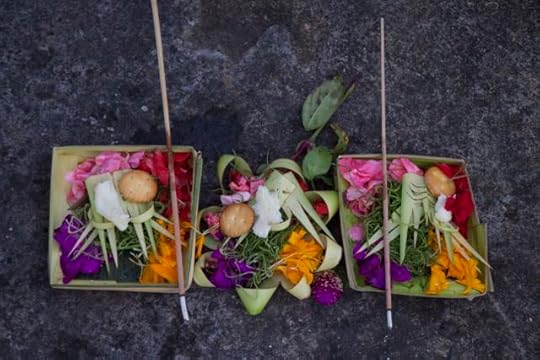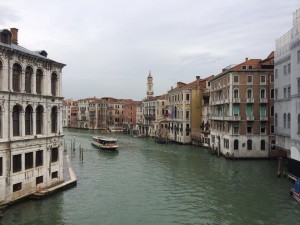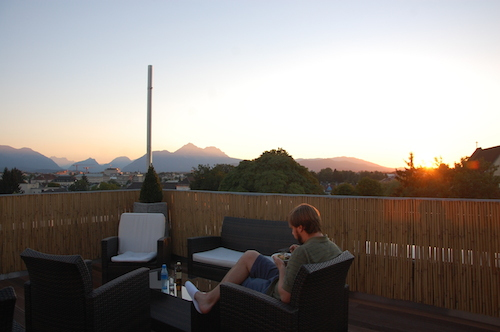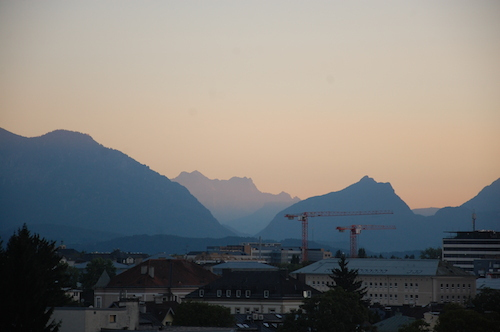Rolf Potts's Blog, page 34
July 14, 2014
Vagabonding Book Club: Chapter 10
Vagablogging :: Rolf Potts Vagabonding Blog
“Thus, travel compels you to discover your spiritual side by simple elimination: Without all the rituals, routines and possessions that give your life meaning at home, you’re forced to look for meaning within yourself…. Indeed, if travel is a process that helps you “find yourself,” it’s because it leaves you with nothing to hide behind– it yanks you out from the realm of rehearsed responses and dull comforts, and forces you into the present. Here in the fleeting moment, you are left to improvise, to come to terms with your raw, true Self.”
Chapter 10 Vagabonding: An Uncommon Guide to the Art of Long-Term World Travel by Rolf Potts
This chapter falls in an interesting week for me, having just finished walking the Camino de Santiago, 800 km, France into Spain a little over a week ago. It was an interesting thing, to make a pilgrimage as a non-religious person. My experience, over the years of travel, has been the same as Rolf’s, in that the moments of greatest spiritual impact and growth have, invariably, been mundane moments and not visits to great temples or sunrise yoga sessions. For me, the forward motion of travel has become a meditation of its own; a ritual that draws me back to the essentials of my internal life. Lightening my physical pack and lightening the internal loads as well.
I love the image of how travel systematically strips away all of the things that we hide behind: material possessions, relationships, jobs and titles, busy-ness, social constructs and a million other things. We’re left standing in the world, naked, with no one looking except ourselves. It is in that moment that we begin to see who we really are. Sometimes it’s necessary to walk naked for quite some distance before we can begin to pick up a few things and clothe ourselves intentionally in the lessons we’ve learned and the discoveries of self as we relate to the whole, in both the temporal and spiritual sense. To me, the truest of spiritual revelations have their boots fully grounded in the mud on the trail.
How about you? Do you travel for spiritual reasons? Where have you been? What have you learned? What surprised you about the journey?
Original article can be found here: Vagabonding Book Club: Chapter 10
July 13, 2014
Travel writing has a way of being perishable
Vagablogging :: Rolf Potts Vagabonding Blog
“Travel writing is perishable. I find that when I’m reading a book of bygone travels I become irritated with curiosity about what the place is like today — can you still swim in the river, as the writer did? Can you still eat the fish? Are the houses still roofed with thatch? This problem has to do not only with travel writing but all nonfiction. If you look in the Classics or Literature section of any bookstore you’ll see mainly works of fiction. Nonfiction is about the physical world, and over time the physical world tends to disappear.”
–Ian Frazier, in They Went: The Art and Craft of Travel Writing (1991)
(1991)
Original article can be found here: Travel writing has a way of being perishable
July 12, 2014
Lessons from a tour guide, part I
Vagablogging :: Rolf Potts Vagabonding Blog
This week I returned from a month and a half overseas working as a tour guide, helping to lead two different groups on an epic Best-of-Europe grand tour. The experience was a new one for me; after years of exploring the continent’s cobbled backstreets and ancient cities as a solo travel writer, I found myself with the unique opportunity of being a guide for one of America’s most well-respected touring companies.
A couple of concerns dogged me as I flew over the Arctic Circle, the plane making its slow path from my home base of Seattle to the tour departure point of Amsterdam. Questions like, how would I be able to handle a large group as we steam across the continent day in and day out? And, how will the mechanics of moving groups from one site to the other in an efficient way work? But these concerns paled next to the most significant challenge: Helping the scores of American travelers connect to the history and culture of the places they came so far to experience.
Staring out my window at the endless expanse of the north Atlantic, I began to feel the weight of the responsibility settle into my gut. How do I curate this experience for our flock? I’d always done it for myself just fine; teaching others how to appreciate the richness of Europe was something I’d never needed to do beyond my writing. It was easy enough to crank out articles about the places I’d visited and about the treasures—the food, the history, the people, all the things that make up the culture—those places had to offer. Would I be able to help our travelers connect to them and appreciate them in the same way that I did?

A final goodbye to the group near the Eiffel Tower at dusk.
The teaching I’d done before—giving free travel talks at public libraries to would-be travelers who were interested in learning how to create their own independent European adventure—was indispensable. The classes I’d taught had given me a sense of what tickled a traveler’s fancy and what common-sense issues they worried about. This gave me the advantage of being able to anticipate questions and concerns, sometime before the group members even knew they had them.
The true challenge was facilitating the tour member’s experience of the culture. It was in trying to cast new food experiences as a part of good travel, as “sightseeing for your palate”. It was in helping them fend off museum overload by urging them to see the art of the Louvre and the Accademia with their hearts rather than their mind. It was in not rushing through another “check the box” locale (don’t rush through St. Mark’s square, I counseled, just take your time and find your own way to relate to the space). And it was in fending off cathedral overload by teaching that architecture was art we walk through—art that took generations of devoted believers and craftsman to create—rather than just another drafty old building.
Helping the group appreciate the elegant, historic decay of Venice is a challenge when the city is crowded and hot.
Finally I kept the old teacher’s maxim close to my heart: “The task of the teacher is to honor the integrity of fact while at the same time igniting the student’s imagination.”
Over the course of the following weeks I’d work on striking that balance, always trying to bring long-ago stories and long-dead people to Technicolor life. Success for the tour guide also means the tourists returning home knowing that the struggles, the tragedies and triumphs of those who inhabited the majestic castles and cobbled city streets so long ago set the stage for the world as we know it today.
The trick to achieving that was helping them forge an emotional connection to the events a given site had witnessed; that its history was not just a collection of faceless dates and facts, but human beings with hopes and dreams who lived in similarly dramatic times of war, economic uncertainty and dramatic social change. Those folks tried to make the best of it, and somehow got through it. We can too. But more than just the appreciation of history, it’s the appreciation of the culture that really informs a successful travel experience. My hope is that the tour members came away with a renewed perspective on how Europe’s endlessly varied tapestry of cultures, while wonderfully diverse, are similar to our own in the most fundamentally human ways.
If you ever find yourself in the trying but satisfying role as tour guide, I think you’ll find that those lessons are your tour members’ best souvenirs.
Original article can be found here: Lessons from a tour guide, part I
July 11, 2014
How to be a traveler in the everyday
Vagablogging :: Rolf Potts Vagabonding Blog
 From the very first time I ever went on a trip, I never wanted to leave. Friends used to tell me they thought I feared reality and wanted to live in a permanent state of holiday. ‘What’s so wrong with that’, I’d reply. It has only gotten worse with age, I’m afraid. I used to think it was because I didn’t have to handle any chores at that time. Since then I’ve gotten sick while traveling, have had to pay bills while on the road and deal with other disheartening realities, but, even to this day, I never want it to end. How do I transfer those travel feelings to the everyday?
From the very first time I ever went on a trip, I never wanted to leave. Friends used to tell me they thought I feared reality and wanted to live in a permanent state of holiday. ‘What’s so wrong with that’, I’d reply. It has only gotten worse with age, I’m afraid. I used to think it was because I didn’t have to handle any chores at that time. Since then I’ve gotten sick while traveling, have had to pay bills while on the road and deal with other disheartening realities, but, even to this day, I never want it to end. How do I transfer those travel feelings to the everyday?
Free. Unencumbered. Happy. At Ease. These are just a few of the terms that travelers often use to describe how they feel when in their happy place. On the road we can be ourselves, be the person we always want to be and not feel as if we have to fit into any specific boxes or deal with any expectations. We can change direction with the wind, be spontaneous or try new things that we’d rarely do in our ‘normal’ setting. Go to the beach on a weekday, hike that mountain you were once afraid of or eat ice cream twice a day-all of these special things take place when we leave the nest. Things are only part of it, but more significant are the changes within that we discover. A different perspective arises, new hobbies take shape, varied taste buds develop and a whole new world opens up that perhaps we never knew-how do we harness those feelings and bring them back ‘to reality’?
Be a tourist in your own city: You know those places you only go to when out-of-towners come to visit? Go see them! Remember the shows that are ‘too expensive’ or the place that’s on ‘the other side of the city’-check them out! Find at least one day a month that you can go on an adventure and see where you live with new and open eyes.
Find joy in the everyday: Do you live by a beautiful boardwalk that sits besides an ocean? Do you have the best view of the city skyline? Can you see endless green vistas in the distance from where you live? Perspective is a wonderful gift and those who learn to embrace it are often some of the happiest. Run your toes through the sand, read a good book in a favourite spot or just people watch at a nearby café-no matter what you do; find a smile and remember that there’s somebody out there who would love to be in your situation.
Venture out and try something new: When I travel, I walk as often as I can but when I come home I find myself jumping in the car because ‘it’s easier’. If I can walk when I travel, why can’t I walk when I’m home? Public transport is not your thing at home-give it a shot. Going to the gym every day getting to you-take a few hours and walk your town to take in the sights we often miss in our harried routines. Never thought you’d be a ‘go on a hike and have a picnic’ kind of person-give it a try and see what happens. Remember the fearlessness that accompanies your travel adventures and channel it to your everyday.
Head to restaurant that reminds you of your travels or find a new place to explore: When you describe that first bite of falafel in Israel your face lights up, eyes dance and mouth waters. Wouldn’t it be nice if you could find it without the airfare price on Elal? How amazing would it be if you could enjoy a mouthwatering fried chickpea extravaganza with delicious yoghurt sauce a few minutes from home at any time you wished? Planning a trip to Vietnam and want to try Pho before you land? How about finding a Vietnamese restaurant to ease in your taste buds? How many of us photograph our meals or walk past a smell that stops us in our tracks and transports us back to a city, stall or market and magically turns the corners of our mouths upwards? Search for that restaurant or even cook it yourself to arouse your taste buds in a new way-your tummies and travel hearts will thank you!
Get outside of your comfort zone: You know that rock climbing Groupon you keep seeing-buy it! When that anti-gravity yoga class comes to town-try it! When your city offers an outdoor movie for free-go to it! A new bicycle shop just opened offering bike tours on the weekends-ride it! The flying trapeze that you always wanted to try to feel like you joined the circus is available on Living Social-it’s your time to fly! Routine happens when we least expect it and travel is one of the few things that forcibly removes us. To add travel to your every day, get outside that comfort zone and find your travel happy!
There’s not always time or money to go on that much desired adventure. If we can find a way to bring the happiness found in travel to the daily routines of life-the everyday can sometimes feel like a holiday! Happy travels.
For more of Stacey’s writings visit her website at thegiftoftravel.wordpress.com.
Original article can be found here: How to be a traveler in the everyday
July 10, 2014
Lesson from Siberia: making it till morning
Vagablogging :: Rolf Potts Vagabonding Blog

(Camping in Siberia)
Earlier this year, I rode a Ural motorcycle and sidecar through Siberia, up 1800km of ice roads and ending in the Arctic Circle. It was one hell of a journey which taught me how to survive in extreme sub-zero temperatures. More importantly, it expanded my limits and showed me what I was capable of.
One of the most important lessons happened on the second night of the trip – our first attempt camping out. Now, I don’t know about you, but I had never camped in extreme cold before. Sure – I had tested out my equipment on a -20C night in South Dakota, but there is a world of difference once you get below -30C. That night was mild, compared to the rest of the trip, but it still hit -32C.
So – we setup camp and tried to building a fire. We could make a lot of smoke, but couldn’t get a strong fire blazing. Fortunately, with the help of a good MSR camp stove, we were able to boil enough water to fill our bellies with pelmeni. Around 9pm we called it a night. I was riding solo, so I had a tent to myself. Quickly I stripped down to base layers and stuffed the upper layers into my sleeping bag to keep them from freezing. After the long day, I fell asleep quickly.
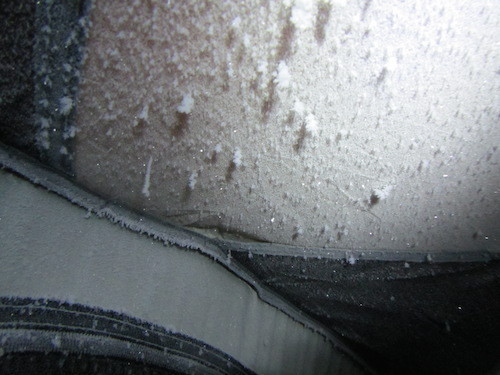
(Waking up inside the tent)
Around midnight, I woke up and realized that I couldn’t feel my toes. Now, one of my biggest fears was getting frostbite and loosing a few digits. I could feel the panic rising; but, after a few slow breaths, I was able to get it under control. I tried flexing my toes, but they wouldn’t move. I took a moment to think about my options – get up and try to get my blood flowing? Aside from my feet, I was warm enough in the sleeping bag. I didn’t know how much body heat I’d lose by getting out. I wasn’t sure how well I’d be able to stand on my numb feet. Too many unknowns, so I decided to stay where I was and move my legs to get blood flowing. After a few minutes of that, my core was getting warmer, but my toes were still numb. Time for a different tack. I had just enough room in my sleeping bag to bring one foot at a time up within reach. I used my hands to manually flex my toes and warmed them up by contact. After a few minutes, I could feel them again and was able to move them just a bit. I switched feet and repeated.
Each time I would put a foot down to work on the other one, it would go numb again. I just couldn’t seem to keep them going without working them with my hands. I kept at it. After I was sure eons had passed, I checked the time, only to be disappointed that only a few minutes had gone by. I began to think things through – I had several hours to go until the sun would come out and temperatures would begin to rise. Would I be able to make it until morning? Did I have another choice?
So that eternally long night, I kept at it – switching feet every few minutes and wishing I could fast forward to morning. I couldn’t control time, though, all I had control over was my will to endure. I began to relax and just focused on the task at hand. Eventually, the sun began to rise. As soon as the inside of the tent began to glow, I breathed a sigh of relief and knew that I would be okay.

(The moment I knew I’d be okay)
I’ve been taught that lesson before – but sometimes a reminder is necessary. Relax, breath and just focus on what is right in front of you. Keep at it long enough and you’ll eventually make it through to the other side.
Later on during the trip, I camped out in harsher temperatures (-43C) but had a much easier time. Partially I’d say it was due to my body acclimating the the environment and also because I learned a couple tricks — like filling a water bottle with boiling water and putting it at the bottom of your sleeping bag to warm it up. That definitely prolongs your comfort and allows you to get a bit of sleep – but trust me, either way, the mornings are still painful.
It’s funny how that these moments turn into a fond memory. Time and distance do strange things.
–
Chris Plough writes and podcasts at oznog.com, where he shares stories and advice from his adventures and from the incredible people that he’s met along the way. You can also follow him on twitter: @chrisplough.
Original article can be found here: Lesson from Siberia: making it till morning
July 9, 2014
Finding a good working environment for travelers with online incomes- the travel-hacker way
Vagablogging :: Rolf Potts Vagabonding Blog
It is hard to get work done in a hostel, if only for the flurry of social activity vying for one’s attention.
The number one reason that my husband and I really appreciate having status with a few of the major hotel chains is for one important detail: free wifi. We work online so honestly, we wouldn’t be able to travel without wifi.
Or some statuses come with free breakfast, lounge access, business center access, and upgrades. All of these things are in no way necessary. Absolutely luxuries and nothing more. But they happen to be luxuries that are perfectly suited for a person working as they travel. It all makes sense really seeing as these statuses were somewhat designed top make life easier for and reward the loyalty of those traveling on business a bulk of the year.
But these perks are just as convenient for travel bloggers, photographers, programmers or anyone else creating an income online.
Traditionally status is for people who stay a ton of nights with a hotel and spend an exorbitant amount of money with them. (Or rather…someone whose business does so). But luckily there are a few hotel statuses that come as perks for having the hotel credit card. Now, this does require a good credit score and an ability to be smart with your credit, but if you make sure that you are using the card for the perks and not as an excuse to spend money you don’t have, then check out the list below of cards that come with hotel status as a perk.
(For a more thorough rundown of hotel loyalty programs, I recommend our infographic about the Best Hotel Rewards Programs.)
I’ve ordered this list from lowest annual fee to highest.
1.) Hilton HHonors Visa: (no annual fee).
Status earned: Silver
Perks of the status: This is one of the lesser impressive statuses as its only real benefit is a 15% increase on points earnings for paid stays. However, the card comes with a 40,000 point bonus after spending $1,000 in 4 months and has no annual fee.
Status earned: Silver
Perks of the status: This is one of the lesser impressive statuses as its only real benefit is a 15% increase on points earnings for paid stays. However, the card comes with a 40,000 point bonus after spending $1,000 in 4 months and has no annual fee.
2.) IHG Rewards Select Visa: ($49 annual fee, waived for the first year).
Status earned: Platinum Status
Perks of the status: This status is a bit more helpful in that it gives 50% increased points earnings as well as free wifi. Also occasionally (though unofficially) you’ll get a free drink voucher or upgrade as well. It’s not a listed benefit but platinums may still get upgrades when visiting the more budget members of the chain like Holiday Inn, Hotel Indigo, etc.
Also worth mentioning, this credit card comes with an anniversary gift of a free night at any IHG property.
3.) Hyatt Credit Card: ($75 annual fee).
Status earned: Platinum
Perks of the status and perks of the card: Again, this status gives 15% increased points earnings as well as free internet. Better than the status perk however is the credit card’s other perk- a certificate for a free night at any category 1-4 Hyatt property. And, after spending $1,000 in 3 months on this card, you’ll earn 2 free night certificates for any Hyatt property.
4.) Club Carlson Visa: ($75 annual fee).
Status earned: Gold
Perks of the status and perks of the card: Much like the others, this status earns 0 more points for stays and comes with free wifi. The card offers 50,000 points (quite generous) after just the first purchase with a possibility of 35,000 more points after spending $2,500 in the first 90 days of having your card.
This card needs some special attention though because of my favorite credit card perk ever: for every stay you reserve with points, card-holders automatically get a free night added on, including for 1 night stays. It’s almost like a buy one get one arrangement! I cannot tell you how much use my husband and I have made of this perk. Obviously this means that we try to use our Club Carlson points in two-night increments (with the second night being free). Then, since you aren’t allowed to just do back to back two night stays and still receive the extra night perk for both of them, we might make a paid stay in-between our two-night blocks for a total of 5 nights, 2 of which are paid for in points, 2 of which are free, and one for which we pay with cash.
5.) Marriott Visa Signature: ($85 annual fee, waived for the first year).
Status earned: Silver
Perks of the status and perks of the card: This is one of the lesser impressive statuses again as it only gets you a increase on points earnings. The perks of the card itself are alright though, earning 50,000 points after spending $1,000 in 3 months as well as 1 free night certificate for a category 1-4 Marriott property. (On the anniversary of this card, you’ll get a category 1-5 certificate.)
6.) Hilton HHonors Reserve: ($95 annual fee).
Status earned: Gold
Perks of the status and perks of the card: This is at last quite a rewarding status. It earns only extra points for stays but comes with free wifi, lounge access, and free breakfast. The lounge access is sometimes just as good as having access to a business center. Not always as sometimes printing and scanning still costs, but some lounges will have a set-up for free printing etc. But the best part is the free food. Not to mention a great, quiet place to work and sip your free coffee.
Otherwise, the only perk of this card is 2 free night certificates after spending $2,500 in the first 4 months of having your card.
As you can see almost all of these cards will get you free wifi, though with an annual fee can you really call that free? Ultimately these cards will only truly be worth it to you if you also take advantage of the points bonuses and/or the free night certificates. You see, travel-hacking is all about maximizing your benefits or at the very least, making sure you’re taking full advantage of all the benefits you’re entitled to.
Here we are enjoying the outdoor seating at a Club Carlson hotel’s lounge in Salzburg.
It could be a very helpful thing to start thinking intentionally about status and points when it comes to hotels. In the case of Club Carlson you could hop across Europe spending your points in a buy-one-get-one fashion and getting free wifi in a comfortable working environment as we did this past year.
Original article can be found here: Finding a good working environment for travelers with online incomes- the travel-hacker way
Vagabonding Field Report: flat tires and bumpy road adventures (while pregnant) in Costa Rica
Vagablogging :: Rolf Potts Vagabonding Blog

Cost/day: $50/day
What’s the strangest thing that’s happened lately?
We left the beach life in Nicaragua and are housesitting in the mountains of Costa Rica, above San Jose.
I’m 8 1/2 months pregnant, but that doesn’t stop us from taking a trip to the beach after we’ve been here a couple of weeks. You can see the ocean from our house in the mountains of Costa Rica, but it appears deceptively close. What we think will be a short drive to enjoy the sun and waves, turns into a 2 hour bumpy, off-road adventure and a flat tire.
I hope I don’t go into labor. 

 Describe a typical day:
Describe a typical day:
Our days have been spent at home at the mountain house, preparing for the birth of our sixth child.
But today we decided to take a trip to the beach today. Two bumpy hours and a flat tire later we finally arrived. The beach was large, the sun shone high, we picked fresh coconuts from the tree and found sand dollars in the sand.

What do you like about where you are? Dislike?
Like: Costa Rica is a beautiful country. We love being back (we lived here in 2007-2008). We’re excited to explore it once more — the beaches, rainforests, oceans, waterfalls and rivers.
Dislike: After living in Guatemala, El Salvador and Nicaragua for the last 1 1/2 years, Costa Rica is comparatively more expensive — housing, food and activities… but I think we’ll adjust. We’re loving it here.

Describe a challenge you faced:
I’ve had all my babies at home (except for my adopted daughter  ) I’d like to have this one at home in Costa Rica, but we’ve been working out logistics… can the midwife make it in time? Is there a hospital nearby?
) I’d like to have this one at home in Costa Rica, but we’ve been working out logistics… can the midwife make it in time? Is there a hospital nearby?

What new lesson did you learn?
Every travel experience offers joy and disappointment, pleasure and pain, beauty and the unsightly. Traveling well is learning how to embrace both… still true.
Where next?
Staying put here for a while… I’m sure you can guess why. 
Learn how to become location independent this year, connect with me on Facebook, or join our Fantastic Family Fridays.
Original article can be found here: Vagabonding Field Report: flat tires and bumpy road adventures (while pregnant) in Costa Rica
July 7, 2014
How to make the most of your Australian Working Holiday Visa
Vagablogging :: Rolf Potts Vagabonding Blog
For many graduates, myself included, a year out to travel the world is seen as a stepping stone on the path to adulthood. Post degree but prior to entering into the working world, a year abroad can provide a few life lessons that are seldom taught within the curriculum of modern education.
The ability to adapt to new circumstances, overcome challenges and stride out forging your own path in life, travel educates in a way that not even the most accomplished and engaging teacher can.
One of the most popular opportunities for graduates seeking the chance to travel is a twelve month Australian Working Holiday Visa. Available to residents of over twenty five countries this visa provides the chance to live and work abroad, explore one of the most diverse continents on the planet and take a class in life that forces you to leap outside your comfort zone.
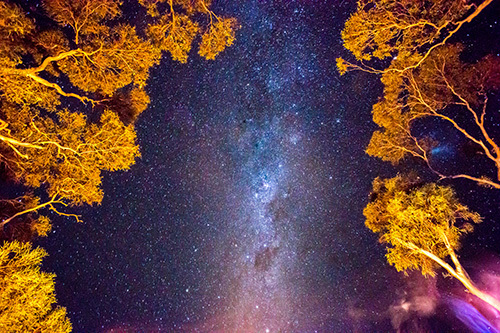
The Milky Way seen from the Nullarbor Plain by Benjamin Jones
Planning twelve months in Australia
One year sounds like ample time to explore one country. However thanks to the sheer scale of the Australian continent and the wealth of landscapes to explore, twelve months will fly past in the blink of an eye when you’re Down Under.
If you’re considering taking the opportunity to sample life in Australia then I highly recommend you take the time to consider exactly what you hope to get out of your stay.
Do you intend to base yourself in one place and seek employment in the field in which you studied while at University? Fly by the seat of your pants and take cash in hand work as you travel across all six states? Perhaps there are certain parts of the country you’re desperate to see and so want to plan an epic road trip?
Whatever you want to do while you’re Down Under here are a few suggestions to help you make the most of your twelve month stay.
Enhance your CV with foreign employment in your field
A working holiday visa is not something every country offers foreign nationals visiting its shores, so consider making the most of the chance to gain employment abroad. If you’re considering immigrating to Australia making connections within the industry you intend to work is invaluable.
A few months prior to your arrival research employers in your sector and reach out to them with your CV detailing your skills and qualifications, and inspiring them to hire you during your stay.
Check online job listings regularly and apply before you arrive. Don’t limit yourself to one location, search countrywide for the greatest chance of success.
Note that under the terms of the visa you are only eligible to work for any one employer for a maximum of six months.
Useful links;
http://www.simplyhired.com.au/
Take an epic road trip across all six states
If you’ve managed to save a few dollars prior to your arrival in Australia then a road trip of epic proportions is one way to maximize your time on the red continent. While the adventure itself will offer an education of unimaginable significance, the experience will help to shape the person you are as you stride out into the big bad world.
Take to the highway and immerse yourself in the heritage of Victoria’s Great Ocean Road, head Ouback and explore the barren red center, explore shipwrecks off the Queensland coast and swim with Dolphins in Western Australia.
Consult the Vagablogging guides to buying a campervan in Australia and selling a vehicle at the end of your stay to ensure you invest wisely, have a hassle free trip and potentially earn a small profit when your adventure is over. Don’t forget you could also earn a few bucks towards your fuel costs by providing a cost effective transport service to other travelers heading the same way as you!

Winifred the Winnebago by Benjamin Jones
Live rent free and see Australia by House Sitting
The concept of house sitting is fast becoming recognized as a tool that can subsidize the cost of accommodation when travelling. In short it offers house and pet owners a low cost option for property and pet care, while providing rent free accommodation for travelers.
If you want to see numerous parts of Australia but don’t have the desire to be on the move for your entire stay, then house and pet sitting is something you should consider. With the chance to live like a local on a reduced daily budget, a house sitting assignment could provide respite from periods of travel and employment.
It’s important to note that some assignments are unsuitable for sitters who are not financially self-sufficient for the duration of their stay, so if you intend to seek employment while house sitting you must mention this in your application. Consider also the logistics of travelling to and from assignments, as well as your transport needs during your stay.
Volunteer for unforgettable experiences
Volunteering is something many associate with charity work but there are a range of volunteer options for those who visit Australia on a working holiday visa. Those travelling on a reduced budget should consider the benefits of an exchange arrangement whereby you donate your time in exchange for room and board.
Australia is well known for its seasonal work and backpackers are often recruited to pick fruit, tend to livestock and assist on rural properties. HelpX is an online listing of host organic farms, non-organic farms, farm stays, homestays, ranches, lodges, B&Bs, backpackers hostels and even sailing boats willing to offer backpackers free lodging in exchange for their help.
Further useful links;
http://www.conservationvolunteers.com.au/

Fossicking in the Queensland Outback by Benjamin Jones
Have you spent twelve months or more in Australia? How would you recommend those on a Working Holiday Visa maximize their stay in the country?
Original article can be found here: How to make the most of your Australian Working Holiday Visa
July 6, 2014
Growing up involves exploring what makes us feel alive
Vagablogging :: Rolf Potts Vagabonding Blog
“A big part of growing up, for everyone, involves exploring what it is that makes us feel not only alive and present, but also competent and respected. With luck, we find passions that are legal and worthwhile, and may be spun upward into hobbies and vocations, rather than downward into self-destruction. These don’t have to center on an adrenalin-filled physical experience. Research by the psychologist Mihaly Csikszentmihalyi, of Claremont Graduate University in California, has shown that gardeners, cooks and heart surgeons can experience rapture — the pleasure of being rapt — of the same kind. So can artists and writers. So can gamers, and those who create the digital worlds they inhabit. Happily, mortal fear turns out not to be necessary — though you can see how it helps. That cherished quality of focus and vitality can come from pushing yourself towards the subtler limits of skill, as well as away from danger.”
–Guy Claxton, Get Your Kicks, Aeon, 11/08/2013
Original article can be found here: Growing up involves exploring what makes us feel alive
July 5, 2014
Best Five Fitness Trackers for Travel
Vagablogging :: Rolf Potts Vagabonding Blog

Travel with its long flights and sitting in transport can wreck havoc on your health. But how can you avoid both while traveling?
The answer is simple: give yourself a challenge. The challenge is in the form of a fitness tracker. As Peter Drucker, an Austrian-born American management consultant, says, “What gets measured, gets managed.”
Fitness trackers aren’t just one-function pedometers anymore. Most track your steps, measure the distance you’ve walked, and time your sleep. A few even capture heart rate, perspiration, body motion, and types of sleep, including how long you spend in REM. When you use a fitness tracker in conjunction with a sleep app, you can kick jet lag.
When I’m traveling, I walk more than I do at home. A fitness tracker not only can measure the quality of my sleep, but also the distance my feet have traveled or how much water I’m consuming — two valuable measurements after recycled air and cramped quarters on flights.
So I rounded up the available fitness trackers and picked the top five based upon factors that are important while traveling:
sleep tracking;
actual distance walked;
unobtrusive design;
battery life.

1. Misfit Shine
Waterproof, minimalist design and has a watch battery rumored to last four months. It has the awesome ability to discern between swimming, walking, running, and cycling. Thanks to its jewelry-like design, you can wear this tracker in a variety of ways; like as a necklace, a watch, clipped to your pants. An interesting sidenote for you startup business fans, Misfit Shine was a successfully funded Indiegogo project. The tracker works in conjunction with an app, available on Android and iTunes.
Downside: you will need a smartphone to get info off the tracker. It doesn’t have a display on it.
Price: $102

2. Jawbone UP24
Sleek wrist band that has a vibrating reminder to urge you to move if you’ve been idle for too long — perfect for a quick walk during a long flight or train ride. Also, the alarm will wake you during a lighter sleep period so you wake easier and quicker. This feature is perfect for adjusting to new time zones. The design looks more like a wrist band than a tracker busily measuring your activity. It claims to have up to 7 days of battery life.
Downside: the unusual design snags on your clothes and you need a smartphone with the app to check your info since it has no display.
Price: $150

3. Fitbit Flex
A slender, comfortable wrist band holds the small Fitbit tracker. Tap on the tracker and lights show your progress to your daily 10,000 step (or any other step!) goal. The tracker works in conjunction with a smartphone app (available on Android and iTunes) which tracks your sleep, water intake, daily mileage walked, total steps, exercise with GPS monitoring, calorie intake. It even has a vibrating alarm to wake you. This is the tracker I use and I can’t wait to try it out on my next trip. My battery life is roughly one week between charges.
Downside: it doesn’t wake you during a lighter sleep period like Jawbone does.
Price: $100

4. Basis
The new kid on the block, this fitness tracker does it all for a great price. It looks like a watch, but thanks to little sensors under the face, it tracks your heart rate patterns, motion, calorie expenditure by activity, perspiration and skin temperature, and sleep cycles including REM. It’s akin to having a doctor strapped to your wrist. This tracker would be very valuable if you are traveling to hotter climates where you run the risk of dehydration and you’re on the move. Battery life is claimed to be up to 4 days. And the strap is carbon steel.
Upside: the larger display shows you info at a glance, no need to pull out the smartphone to check it.
Price: $200
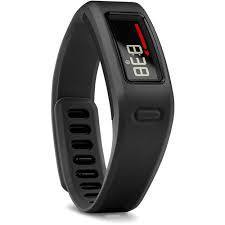
5. Garmin Vivofit
Best part is you don’t have to charge it for a year. Reviews by the users back up that stat. When it needs new batteries, they are common batteries found at any store. This tracker does everything else all the other trackers listed do. But it also pairs with a heart rate strap. And the display provides more information like time, steps, distance, calories.
Price: $130
Laura blogs at Waiting To Be Read where she explores the benefits of reading and traveling, is forever making “best of” lists, and writes book reviews with actors cast as main characters.
Original article can be found here: Best Five Fitness Trackers for Travel
Rolf Potts's Blog
- Rolf Potts's profile
- 323 followers


